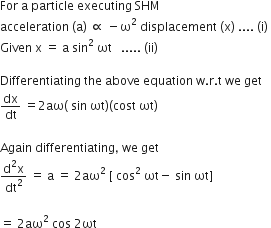 Multiple Choice Questions
Multiple Choice QuestionsIf we study the vibration of a pipe open at both ends, then the following statements is not true
open end will be anti-node
Odd harmonics of the fundamental frequency will be generated
All harmonics of the fundamental frequency will be generated
All harmonics of the fundamental frequency will be generated
A source of unknown frequency gives 4 beats/s when sounded with a source of known frequency 250 Hz. The second harmonic of the source of unknown frequency gives five beats per second when sounded with a source of frequency 5.13 Hz. The unknown frequency is
250 Hz
246 Hz
240 Hz
240 Hz
Out of the following functions representing motion of a particle which represents SHM
Only (IV) does not represent SHM
(I) and (III)
(I) and (II)
(I) and (II)
A string is stretched between fixed points separated by 75.0 cm. It is observed to have resonant frequencies of 420 Hz and 315 Hz. There are no other resonant frequencies between these two. The lowest resonant frequency for this strings is
155 Hz
205 Hz
10.5 Hz
10.5 Hz
A particle is executing a simple harmonic motion. Its maximum acceleration is α and maximum velocity is β. Then, its time period of vibration will be
β2/α2
α/β
β2/α
β2/α
 are functions of time, then the value of t at which they are orthogonal to each other
are functions of time, then the value of t at which they are orthogonal to each other




Two particle are oscillating along two close parallel straight lines sides by sides, with the same frequency and amplitudes. They pass each other, moving in opposite directions when their displacement is half of the amplitude. The mean position of the two particles lie on a straight line perpendicular to the paths of the two particles.
The phase difference is
zero
2π/3
π
π
The displacement of a particle along the x-axis is given by x = a sin2 ωt. The motion of the particle corresponds to
simple of harmonic motion of frequency ω/π
simple harmonic motion of frequency 3ω/2π
non simple harmonic motion
non simple harmonic motion
D.
non simple harmonic motion

The period of oscillation of mass M suspended from a spring of negligible mass is T. If along with it another mass M is also suspended, the period of oscillation will now be
T

2T
2T
A simple pendulum performs simple harmonic motion about x = 0 with an amplitude a and time period T. the speed of the pendulum at x = a/2 will be

πa / T
3π2a / T
3π2a / T
